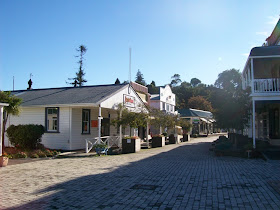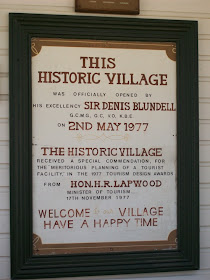Image: Tauranga, New Zealand, 23 April 1864, by Col. Edward Arthur Williams (1824-1898).
From interpretive panels, Faulkner House.
One thing that gets me about Tauranga's history -- it almost always seems that it has to be teased out to be discovered, like teasing out a piece of yarn. That's probably the reason why I enjoyed my weekend down there this year so much and have good memories. Having history served up on a platter, ready cooked, pre-seasoned; all that's left is to either savour it, or pick it apart to find the fishbones of contention. Much of Auckland's history, well-documented, still argued over, is like that.
But for some reason, Tauranga's story seems to demand that you go look for it. A real case in point is the Historic Village there.
Image: Plan of Tauranga District, 4 May 1867, by James McKay, Civil Commissioner.
From interpretive panels, Faulkner House.
When you come up to the admin office -- you'll get a map of the village. Very cool -- but there's nothing on it to tell you about the village, how it came to be, and even which buildings are real structures inherited from the past, and which ones are mock-ups built specially to remind you of the past. Frustrating ... but I did carry on, and eventually found out kind of how things came to be. At least in summary.
Tauranga in its early days had a Mechanics Institute, much like most towns up band down the country in the 19th century -- a place where the working man could read and learn in a culture which prized learning, knowledge, and education. Some of the Institutes, because a library was at their core, spawned the public library system we know today in various places. In Tauranga, it seems (according to the panels I found at Faulkner House -- more on that later) it led to a museum. The organisers gathered a collection -- which went up in smoke when the Mechanics Institute burned in 1881. Undaunted, they gathered subscriptions and erected a replacement building, and started gathering anew.
Fast forward to 1938, when all of sudden "a collection of rare and valuable exhibits" found temporary resident in the Tauranga Town Hall which, just out of interest, also served as a part-time movie theatre.
Come World War II, however, with no permanent home found, the collection was packed up in three cases and stored away, secured into a wall at the Town Hall. It remained there until 1954 when members of the Tauranga Historical Society found references to the collection in the records, and unblocked the wall. But, down to 1969, there was still no permanent home for the collection. It was even suggested that the quest be given up, and the items sent to Auckland War Memorial Museum.
But, in that year, the Tauranga District Museum was finally established, with a facility on Hamilton Street. 900 people attended the opening on 22 August 1970. The Hamilton Street museum ran until 1976.
From 1972, plans were prepared for a historic village, depicting Tauranga between 1880 and 1920 on the 14 acre Thomas Wrigley Reserve at the western end of 17th Avenue. It finally opened 11 December 1976. It once had a tug-boat named the Taioma, displayed high and dry on land. Later, she was scuttled. Today, the Taioma is now a featured wreck off the southern side of Motiti Island. It once had a small railway, and L508, affectionately called "Gertie". It was purchased in 1974, and remained until the museum's demise 14 years later. Today, "Gertie" is at Shantytown in Greymouth.
From 1972, plans were prepared for a historic village, depicting Tauranga between 1880 and 1920 on the 14 acre Thomas Wrigley Reserve at the western end of 17th Avenue. It finally opened 11 December 1976. It once had a tug-boat named the Taioma, displayed high and dry on land. Later, she was scuttled. Today, the Taioma is now a featured wreck off the southern side of Motiti Island. It once had a small railway, and L508, affectionately called "Gertie". It was purchased in 1974, and remained until the museum's demise 14 years later. Today, "Gertie" is at Shantytown in Greymouth.
What happened was a decline in visitor numbers from 1990. A decision was made in 1998 to close the historic village down, with the view to building a modern museum facility -- but that has yet to happen. Meanwhile, the collection was put in storage. The village itself remained, however, with a new life as the headquarters for a number of community groups and businesses.
So, here it is -- Tauranga's Historic Village on 17th.
This Town Board and Library building is one of my favourites ...
... because it's home to the Tauranga Gem & Mineral Club, with a wonderful display area, and samples on sale to suit any budget.
Charlie Haua's Smithy -- purchased for £500 by the Tauranga Historical Society in 1969-1970 for the Tauranga District Museum.
The base of the lamp features the plaque for a foundation stone laid at King Edward VII Esplanade on 9 August 1902 by Mayor Charles Jordan.
Even a mural for me to photograph ...
Sad to say, this picturesque little church is one of the fake buildings. But the doors came from the Catholic church at Maketu.
But this, Faulkner Cottage, is one of the real ones.
I saw on the map that there was a collection of gravestones -- but alas, I was too late. They'd been removed in late 2010.































































LOL plant thieves will be composted :)
ReplyDeleteLovely post! I'll have to make sure i visit!
Cheers
S
You'd love it, Sandy. No gravestones there, of course (sigh) -- but you'd love it.
ReplyDeleteThanx so much for this post: I'd never heard of this place before. Next time I'm down there, I'll definitely pay a visit!
ReplyDeleteI didn't know what to expect (the NZ Federation of Historical Societies' annual conference & AGM was held there) -- but I was pleasantly surprised. Take a car, though, to the western end of 17th -- the hill up from the reserve is one heck of a climb!
ReplyDeleteAnd people say we need a museum - we already have a fantastic one
ReplyDeleteSo, as noted, a few individuals in positions of influence manipulated processes and outcomes to incrementally undermine the Tauranga Museum, as their desire for a multi-million dollars structure in the Central Business District influenced their every decision in regards a home for our heritage. Sadly, today, those same forces seek to subvert democratic processes, denying the community of Tauranga ANY meaningful say lest they should say, "We have a museum, it is in 17th Avenue, it is in Brown Street (The Elms), and WE WANT IT BACK."
ReplyDeleteJust proves Tga is a soulless town. Even Gisborne has a fully blown museum
ReplyDeleteSomething they are working on rectifying right now - - a $50 million new museum is on the drawing boards.
DeleteI was one of a family of volunteers at this Village in 1979-early 80s. Mum worked at the ticket office, my sister and I worked in the corner shop, a brother worked at the smithy and another brother drove the fire engine and double decker bus. I remember as a Sea Cadet attending the opening of the Taioma there...fascinating time in Tauranga's past and I'm so glad to have experienced volunteering there as a teenager.
ReplyDeleteHay, you should come back and visit, the Historic Village has changed alot in the last 10 years. Time for some updated photos! :)
ReplyDeleteI intend doing so. I like visiting Tauranga. :)
DeleteTook the kids there in the school holidays. The above description to me was quite accurate. The place has massive potential but bugger all historic photos or stories on the streetscape. Add a few big photos and stories about bank robbers and cowboy types in the region over the past 200 years would be a cheap way to add a huge amountto the experience. Surely there are a few good yarns.
ReplyDelete